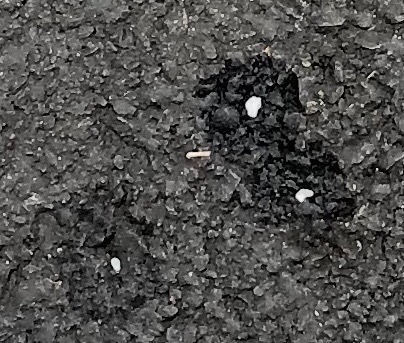The other day I noticed something so interesting in a parking lot that I took a photograph:

Temperatures the night before had plunged below freezing and apparently the owners of the parking lot had sprinkled salt to melt any ice. By the time I arrived, any ice had melted and much of the water had evaporated — but there remained a bit of water surrounding each salt crystal. At first, this surprised me, but a moment’s reflection revealed the explanation. Here’s a closeup of some salt crystals:

The salt had partly dissolved into the water in close contact with it, so the water we see here is salty water. When salt dissolves in water, the salt molecule breaks into its two components, sodium and chorine, surrounded by water molecules. Here’s a good explanation of the process. In the process, energy is released, because the water molecules are ionically bonded to the two ions (sodium and chlorine). Now that they are sticking to the sodium and chlorine ions, it takes more energy to pull them away so that they can evaporate into the air. Thus, the salty water doesn’t evaporate as readily as the fresh water.
This also explains why salty water freezes at a lower temperature than fresh water — which is why people salt the roads in the first place. Seawater freezes at 28.4ºF, and water saturated with salt (containing so much salt that no more salt will dissolve in it) remains liquid all the way down to -6ºF.
